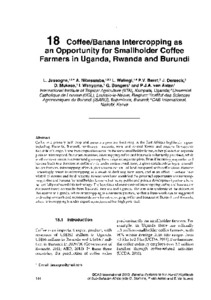| dc.contributor.author | Jassogne, Laurence T.P. |
| dc.contributor.author | Nibasumba, A. |
| dc.contributor.author | Wairegi, L. |
| dc.contributor.author | Baret, P.V. |
| dc.contributor.author | Deraeck, J. |
| dc.contributor.author | Mukasa, D. |
| dc.contributor.author | Wanyama, I. |
| dc.contributor.author | Bongers, G. |
| dc.contributor.author | Asten, Piet J.A. van |
| dc.date.accessioned | 2019-12-04T11:07:50Z |
| dc.date.available | 2019-12-04T11:07:50Z |
| dc.date.issued | 2013 |
| dc.identifier.citation | Jassogne, L., Nibasumba, A., Wairegi, L., Baret, P.V., Deraeck, J., Mukasa, D. ... & Van Asten, P.J.A. (2013). Coffee/Banana intercropping as an opportunity for smallholder coffee farmers in Uganda, Rwanda and Burundi. In G. Blomme, P. Van Asten and B. Vanlauwe, Banana systems in the humid highlands of sub-Saharan Africa, (p.144-149). Wallingford: CABI. |
| dc.identifier.isbn | 978-1-78064-231-4 |
| dc.identifier.uri | https://hdl.handle.net/20.500.12478/1612 |
| dc.description.abstract | Coffee is a primary cash crop and banana a primary food crop in the East African highlands region, including Rwanda, Burundi, north-west Tanzania, west and central Kenya and eastern Democratic Republic of Congo. These two crops often occur on the same smallholder farms, either planted on separate plots or intercropped. In certain countries, intercropping coffee and banana is voluntarily practised, while in others governments recommend growing these crops on separate plots. Even if intercropping coffee and banana leads to a decrease in coffee yields under certain conditions, it gives certain advantages to smallholder farmers. Intercropping offers higher returns per unit of land compared with coffee alone. Farmers increasingly resort to intercropping as a result of declining farm sizes, and in an effort to reduce risks related to income and food security. Researchers have identified the potential opportunity for intercropping coffee and banana for smallholder farmers, but many public and private development partners have not yet fully embraced this technology. The benefits and constraints of intercropping coffee and banana are discussed based on results from Burundi, Rwanda and Uganda. The aim is to understand the drivers of this system in Uganda, where intercropping is a common practice, so that a framework can be suggested
to develop research and recommendations for intercropping coffee and bananas in Burundi and Rwanda, where intercropping is under experimentation and has high potential. |
| dc.format.extent | 144-149 |
| dc.language.iso | en |
| dc.publisher | Centre for Agriculture and Biosciences International |
| dc.subject | Coffee |
| dc.subject | Bananas |
| dc.subject | Cropping Systems |
| dc.subject | Food Security |
| dc.subject | Farming Systems |
| dc.subject | Technology Transfer |
| dc.subject | Smallholders |
| dc.subject | Intercropping |
| dc.title | Coffee/Banana intercropping as an opportunity for smallholder coffee farmers in Uganda, Rwanda and Burundi |
| dc.type | Book Chapter |
| dc.description.version | Peer Review |
| cg.contributor.crp | Climate Change, Agriculture and Food Security |
| cg.contributor.crp | Integrated Systems for the Humid Tropics |
| cg.contributor.affiliation | International Institute of Tropical Agriculture |
| cg.contributor.affiliation | Université Catholique de Louvain |
| cg.contributor.affiliation | Institut des Sciences Agronomiques du Burundi |
| cg.contributor.affiliation | CAB International |
| cg.coverage.region | Africa |
| cg.coverage.region | Central Africa |
| cg.coverage.region | East Africa |
| cg.coverage.country | Burundi |
| cg.coverage.country | Rwanda |
| cg.coverage.country | Uganda |
| cg.authorship.types | CGIAR and developing country institute |
| cg.iitasubject | Agronomy |
| cg.iitasubject | Banana |
| cg.iitasubject | Farming Systems |
| cg.iitasubject | Smallholder Farmers |
| cg.howpublished | Formally Published |
| cg.publicationplace | Wallingford, UK. |
| cg.accessibilitystatus | Limited Access |
| local.dspaceid | 82423 |
| cg.targetaudience | Scientists |

